
Huntsman spiders, members of the family Sparassidae, are known by this name because of their speed and mode of hunting. They are also called giant crab spiders because of their size and appearance. Larger species sometimes are referred to as wood spiders, because of their preference for woody places. In southern Africa the genus Palystes are known as rain spiders or lizard-eating spiders. Commonly, they are confused with baboon spiders from the Mygalomorphae infraorder, which are not closely related.

Barry James Marshall is an Australian physician, Nobel Laureate in Physiology or Medicine, Professor of Clinical Microbiology and Co-Director of the Marshall Centre at the University of Western Australia. Marshall and Robin Warren showed that the bacterium Helicobacter pylori plays a major role in causing many peptic ulcers, challenging decades of medical doctrine holding that ulcers were caused primarily by stress, spicy foods, and too much acid. This discovery has allowed for a breakthrough in understanding a causative link between Helicobacter pylori infection and stomach cancer.

Orb-weaver spiders are members of the spider family Araneidae. They are the most common group of builders of spiral wheel-shaped webs often found in gardens, fields, and forests. The English word "orb" can mean "circular", hence the English name of the group. Araneids have eight similar eyes, hairy or spiny legs, and no stridulating organs.
Sunrise is an Australian breakfast show program. It is broadcast on the Seven Network, and is currently hosted by Natalie Barr and Matt Shirvington. The program follows Sunrise Early News, and runs from 5:30 am to 9:00 am. It is followed by The Morning Show.

Austracantha is a genus of spider with a single species, Austracantha minax, commonly known as the jewel spider or the Christmas spider. It is a member of the family Araneidae and is endemic to Australia. They are relatively small spiders, reaching a maximum total body length of only around 12 mm (0.47 in) for females, and 5 mm (0.20 in) for males. Their abdomen has six distinctive projections ("spines") that makes them easy to identify. They are predominantly a shiny black, with variable white, yellow, and orange patterns. Melanistic forms also occur during autumn. They are facultatively gregarious, and can be found in large aggregations of overlapping orb webs. They feed on small flying insects that get entangled in their webs. They are harmless to humans, though the webs can be a nuisance for bushwalkers. They are most abundant during the summer months.
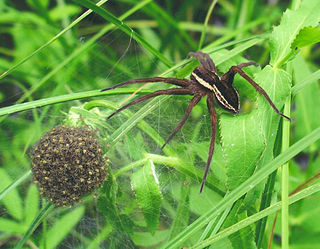
Dolomedes is a genus of large spiders of the family Pisauridae. They are also known as fishing spiders, raft spiders, dock spiders or wharf spiders. Almost all Dolomedes species are semiaquatic, with the exception of the tree-dwelling D. albineus of the southeastern United States. Many species have a striking pale stripe down each side of the body.
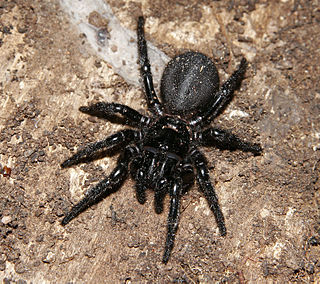
Hadronyche is a genus of venomous Australian funnel-web spiders that was first described by L. Koch in 1873. Originally placed with the curtain web spiders, it was moved to the Hexathelidae in 1980, then to the Atracidae in 2018.

The bush coconut, or bloodwood apple, is an Australian bush tucker food. It is an insect gall with both plant and animal components: an adult female scale insect and her offspring live in a gall induced on a bloodwood eucalypt tree (Corymbia). Bush coconuts can vary from golf ball to tennis ball size. They have a hard and lumpy outer layer. The inner layer is a white flesh that contains the female insect and her offspring. There are three known species of Cystococcus responsible for forming the bush coconut: Cystococcus pomiformis, Cystococcus echiniformis and Cystococcus campanidorsalis. C. pomiformis is the most common species. The bush coconut is found in Western Australia, the Northern Territory, Queensland and New South Wales.
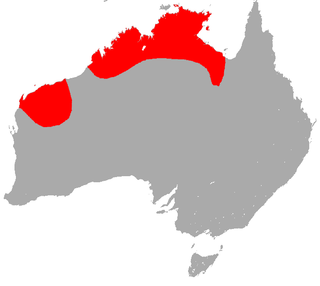
The common sheathtail bat, is a bat in the family Emballonuridae, occurring in northern Australia.

The rufous songlark is a species in the family Locustellidae endemic to Australia.

Argiope protensa, commonly known as the tailed grass spider or teardrop spider, is a species of spider in the orb weaver family, Araneidae. This species is fairly common and widespread in Australasia, but like many spider species, little is known of its ecology, biology, or life history.

The black-naped tern is an oceanic tern mostly found in tropical and subtropical areas of the Pacific and Indian Oceans. It is rarely found inland.

Psychopsidae is a family of winged insects of the order Neuroptera. They are commonly called silky lacewings.
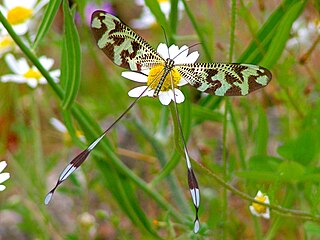
Nemoptera bipennis is a species of slow flying insect in the spoonwing family, Nemopteridae. It is found in Spain, Portugal, and France. Nemoptera bipennis lives in calcareous areas with low vegetation.
Forsterina is a genus of South Pacific intertidal spiders that was first described by Pekka T. Lehtinen in 1967.
Nemia is a genus of insects belonging to the family Nemopteridae.
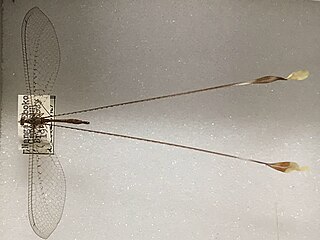
Nemopistha hennini is a Neuropteran insect species described by Luisa Eugenia Navas in 1911, which is found in the Congo Basin. N. hennini is part of the genus Nemopistha and the family Nemopteridae. No subspecies are listed in the Catalog of Life.

Chasmoptera is a genus in the Nemopteridae. The genus, which consists of three species, is wholly confined to Western Australia.

Chasmoptera huttii is an insect in the spoonwing family (Nemopteridae). found in Western Australia.

Chasmoptera superba is an insect in the spoonwing family (Nemopteridae). endemic to Western Australia.
















